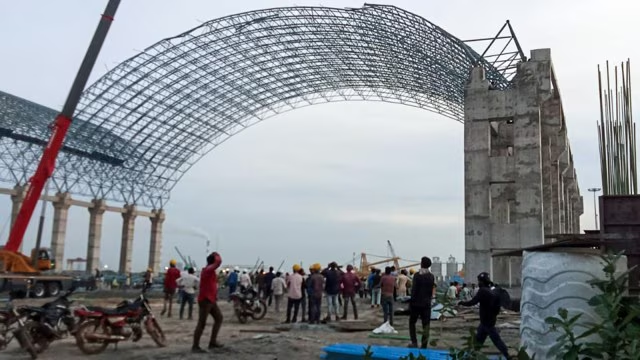The Trench of Broken Dreams: A City’s Ambition, A Nation’s Neglect, and Nine Lives Lost

Image via The Indian Express
CHENNAI – The morning began like any other at the labour camp, a makeshift city of tin and hope huddled in the shadow of the half-built luxury apartment complex it served. Before the Chennai sun grew unforgiving, the air was filled with the familiar sounds of men waking—the murmur of Assamese, the clatter of steel cups, the sizzle of tea. They were thousands of kilometers from their homes, but here, in this small pocket of a foreign city, they had each other. They spoke of the rains back in their villages, of the money they would send home next, of the day they could finally return.
By midday on Tuesday, nine of these men were dead, their voices silenced, their dreams buried under tons of collapsed earth. A deep trench at the construction site, their place of work, had caved in, becoming an instant, unmarked grave. They had come to Chennai to build a city’s ambitions, but all they found was a six-foot-deep trench of broken dreams.
This is not just a story of a tragic accident. It is a story of a national shame, of the perilous journey of India’s invisible citizens—the migrant workers—whose lives are the price paid for the glittering skylines of our modern cities.
The Question That Hangs in the Dust
In the chaotic hours after the collapse, as rescue teams frantically clawed at the earth, a young man named Anisur, his face a mask of grief and dust, stood watching. He had been working just a few feet away and had narrowly escaped. His cousin, Rahim, was not so lucky. Surrounded by reporters, Anisur’s sorrow gave way to a flash of raw, unfiltered anger.
“They ask us, ‘Why do you come here for this dangerous work? Why not stay home?'” he cried, his voice trembling. “I have a question for them. Why would we leave our homes? Why would we leave our mothers, our wives, our children, if there was work for us there? Does anyone think we like living in these tin sheds, risking our lives every single day? We are here because we have no other choice.”
That one question—”Why would we leave?”—hangs over the tragedy in Karur. It is not just the cry of a grieving friend; it is an indictment of a system that offers its most vulnerable citizens a devastating choice: the certainty of poverty at home or the possibility of death far away.
Portraits of a Journey, Interrupted
Rahim Ali (name changed), at 22, was one of the youngest. His village in Assam is a place of breathtaking beauty and brutal uncertainty, where the mighty Brahmaputra river gives life but also takes it away, year after year, eroding farmlands and livelihoods. Rahim came to Chennai with a single-minded purpose: to earn enough to rebuild his family’s flood-damaged home and to ensure his sister had a proper wedding. He was the family’s great hope.
Bipin Das (name changed), 48, was the veteran. He knew the risks. He had seen accidents before. But his two daughters were in college, the first in their family to get so far. The daily wage of ₹600 he earned in Chennai was the fuel for their aspirations. His own dream was simple: that his daughters would one day have jobs that would allow them to live with dignity, to never know the fear he felt every time he descended into an unsecured trench.
An Ecosystem of Exploitation
The trench that killed Rahim, Bipin, and seven of their brothers was, according to safety experts, a death trap waiting to happen. At over 15 feet deep, regulations mandate that its walls be reinforced with strong shoring or cut back at a safe angle. These precautions were ignored. It was a calculated risk, a cost-saving measure in an industry where the lives of migrant workers are often the cheapest and most expendable commodity.
This tragedy was enabled by an entire ecosystem of exploitation. The main developer of the luxury complex will likely blame the primary contractor. The contractor will blame the sub-contractor, who in turn will blame the local labour agent, or sardar, who brought the men from Assam. This multi-layered system is designed to diffuse liability, ensuring that when a disaster strikes, it is nearly impossible to hold the powerful entities at the top of the food chain accountable. The FIR filed by the police names the site supervisor and the sub-contractor, but the chain of responsibility vanishes into the corporate boardrooms.
The Bureaucracy of Death
For Anisur and the other survivors, the horror did not end with the collapse. It continued in the cold, sterile corridors of a government hospital morgue, where they faced the heartbreaking task of identifying the mutilated bodies of their friends and relatives. They had to navigate a bewildering bureaucracy in a language they barely understood, filling out forms and answering questions, all while drowning in unimaginable grief.
Now, they face the final, agonizing journey: arranging for the transport of nine coffins back to nine different villages in Assam. The government has announced a paltry ex-gratia payment, a sum that barely begins to cover the lifelong loss of a family’s primary breadwinner.
The nine men who died on Tuesday began their journey to Chennai on a train, their hearts full of a desperate hope. They will return on that same train line, their bodies in wooden boxes, their hopes extinguished forever. They were not just victims of falling earth. They were victims of a nation’s neglect, of a development model that sees their labour as essential but their lives as disposable. The trench that claimed them was dug not just by their own hands, but by the relentless machinery of inequality.